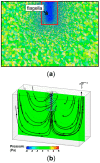Thrust and Hydrodynamic Efficiency of the Bundled Flagella
- PMID: 31277385
- PMCID: PMC6680724
- DOI: 10.3390/mi10070449
Thrust and Hydrodynamic Efficiency of the Bundled Flagella
Abstract
The motility mechanism of prokaryotic organisms has inspired many untethered microswimmers that could potentially perform minimally invasive medical procedures in stagnant fluid regions inside the human body. Some of these microswimmers are inspired by bacteria with single or multiple helical flagella to propel efficiently and fast. For multiple flagella configurations, the direct measurement of thrust and hydrodynamic propulsion efficiency has been challenging due to the ambiguous mechanical coupling between the flow field and mechanical power input. To address this challenge and to compare alternative micropropulsion designs, a methodology based on volumetric velocity field acquisition is developed to acquire the key propulsive performance parameters from scaled-up swimmer prototypes. A digital particle image velocimetry (PIV) analysis protocol was implemented and experiments were conducted with the aid of computational fluid dynamics (CFD). First, this methodology was validated using a rotating single-flagellum similitude model. In addition to the standard PIV error assessment, validation studies included 2D vs. 3D PIV, axial vs. lateral PIV and simultaneously acquired direct thrust force measurement comparisons. Compatible with typical micropropulsion flow regimes, experiments were conducted both for very low and higher Reynolds (Re) number regimes (up to a Re number = 0.01) than that are reported in the literature. Finally, multiple flagella bundling configurations at 0°, 90° and 180° helical phase-shift angles were studied using scaled-up multiple concentric flagella thrust elements. Thrust generation was found to be maximal for the in-phase (0°) bundling configuration but with ~50% lower hydrodynamic efficiency than the single flagellum. The proposed measurement protocol and static thrust test-bench can be used for bio-inspired microscale propulsion methods, where direct thrust and efficiency measurement are required.
Keywords: bacteria locomotion; computational fluid dynamics; flagellar propulsion; microswimmer; particle image velocimetry.
Conflict of interest statement
The authors declare no conflict of interest.
Figures












Similar articles
-
Microswimmer Propulsion by Two Steadily Rotating Helical Flagella.Micromachines (Basel). 2019 Jan 18;10(1):65. doi: 10.3390/mi10010065. Micromachines (Basel). 2019. PMID: 30669288 Free PMC article.
-
Propulsion Mechanism of Flexible Microbead Swimmers in the Low Reynolds Number Regime.Micromachines (Basel). 2020 Dec 15;11(12):1107. doi: 10.3390/mi11121107. Micromachines (Basel). 2020. PMID: 33333847 Free PMC article.
-
Inter-Laboratory Characterization of the Velocity Field in the FDA Blood Pump Model Using Particle Image Velocimetry (PIV).Cardiovasc Eng Technol. 2018 Dec;9(4):623-640. doi: 10.1007/s13239-018-00378-y. Epub 2018 Oct 5. Cardiovasc Eng Technol. 2018. PMID: 30291585
-
Physics of microswimmers--single particle motion and collective behavior: a review.Rep Prog Phys. 2015 May;78(5):056601. doi: 10.1088/0034-4885/78/5/056601. Epub 2015 Apr 28. Rep Prog Phys. 2015. PMID: 25919479 Review.
-
Flagella-Driven Motility of Bacteria.Biomolecules. 2019 Jul 14;9(7):279. doi: 10.3390/biom9070279. Biomolecules. 2019. PMID: 31337100 Free PMC article. Review.
Cited by
-
Magnetic Cilia with Programmable Beating Patterns for Vortex-Driven Mixing in Microfluidics.Langmuir. 2025 Aug 19;41(32):21562-21575. doi: 10.1021/acs.langmuir.5c02350. Epub 2025 Jul 31. Langmuir. 2025. PMID: 40739946 Free PMC article.
-
Microfluidic Applications of Artificial Cilia: Recent Progress, Demonstration, and Future Perspectives.Micromachines (Basel). 2022 May 3;13(5):735. doi: 10.3390/mi13050735. Micromachines (Basel). 2022. PMID: 35630202 Free PMC article. Review.
-
Physics of swimming and its fitness cost determine strategies of bacterial investment in flagellar motility.Nat Commun. 2025 Feb 18;16(1):1731. doi: 10.1038/s41467-025-56980-x. Nat Commun. 2025. PMID: 39966405 Free PMC article.
References
-
- Taylor G. The action of waving cylindrical tails in propelling microscopic organisms. Proc. R. Soc. Lond. Ser. A Math. Phys. Sci. 1952;211:225–239.
-
- Lauga E., Powers T.R. The hydrodynamics of swimming microorganisms. Rep. Prog. Phys. 2009;72:096601. doi: 10.1088/0034-4885/72/9/096601. - DOI
-
- Martel S. Swimming microorganisms acting as nanorobots versus artificial nanorobotic agents: A perspective view from an historical retrospective on the future of medical nanorobotics in the largest known three-dimensional biomicrofluidic networks. Biomicrofluidics. 2016;10:021301. doi: 10.1063/1.4945734. - DOI - PMC - PubMed
LinkOut - more resources
Full Text Sources
Miscellaneous

